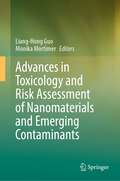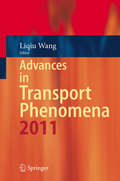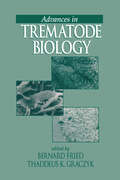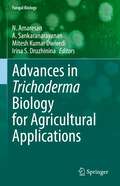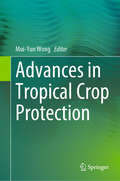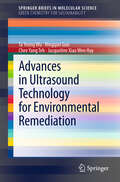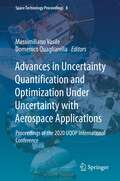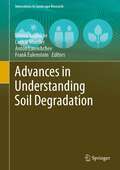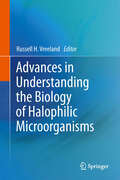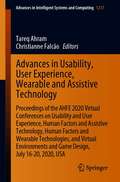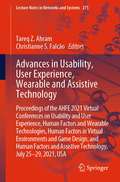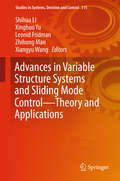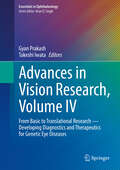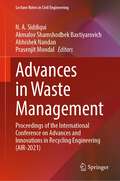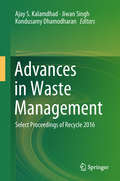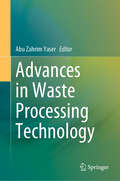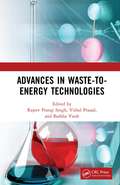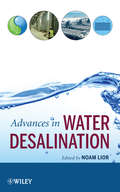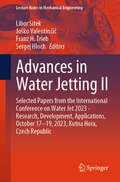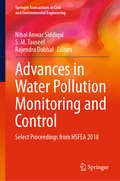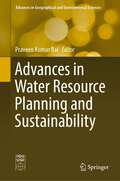- Table View
- List View
Advances in Toxicology and Risk Assessment of Nanomaterials and Emerging Contaminants
by Liang-Hong Guo Monika MortimerThis book details the state-of-the-art methodological advances for delineating the toxicology and working mechanisms of nanomaterials, microplastics, fine aerosol particulates (PM2.5) as well as emerging organic pollutants. It also provides latest computational approaches for toxicity prediction and risk assessment of nanoscale materials which possess realistic chances to enter the environment and human organism. Written by leading scientists at the frontiers of environmental science and nanomedicine, this book is intended for both young researchers and experienced professionals working in the fields of environmental protection, human health and occupational safety, nanotechnology, material science and nanomedicine, as well as graduate students majoring in environmental and health sciences.
Advances in Transitional Flow Modeling: Applications to Helicopter Rotors (SpringerBriefs in Applied Sciences and Technology)
by Chunhua ShengThis book provides a comprehensive description of numerical methods and validation processes for predicting transitional flows based on the Langtry-Menter local correlation-based transition model, integrated with both one-equation Spalart-Allmaras (S-A) and two-equation Shear Stress Transport (SST) turbulence models. A comparative study is presented to combine the respective merits of the two coupling methods in the context of predicting the boundary-layer transition phenomenon from fundamental benchmark flows to realistic helicopter rotors. The book will of interest to industrial practitioners working in aerodynamic design and the analysis of fixed-wing or rotary wing aircraft, while also offering advanced reading material for graduate students in the research areas of Computational Fluid Dynamics (CFD), turbulence modeling and related fields.
Advances in Transport Phenomena 2011 (Advances in Transport Phenomena #3)
by Liqiu WangThis new volume of the annual review "Advances in Transport Phenomena" series contains three in-depth review articles on the microfluidic fabrication of vesicles, the dielectrophoresis field-flow fractionation for continuous-flow separation of particles and cells in microfluidic devices, and the thermodynamic analysis and optimization of heat exchangers, respectively.
Advances in Trematode Biology
by Bernard Fried Thaddeus K. GraczykTrematodology - the study of a class of medically important parasitic, flat-bodied worms - has made significant advances over the past ten years. The tremendous amount of information accumulated from research discoveries and technical developments related to trematode biology makes this book a timely and necessary part of the literature. Advances in Trematode Biology presents a thorough treatment of modern trematodology, including principles and practices. With coverage of background material as well as modern methods, Advances in Trematode Biology updates researchers, practitioners, and students with new information in immunology, biochemistry, physiology, and molecular biology. Advances in Trematode Biology includes practical information on parasitological techniques, emphasizing species of medical and veterinary importance - a key reference for parasitologists, biologists, medical, and veterinary personnel. The excellent presentation of material, including well-organized tables and chapters, make Advances in Trematode Biology easy to use both as a textbook and as a reference.
Advances in Trichoderma Biology for Agricultural Applications (Fungal Biology)
by Irina S. Druzhinina A. Sankaranarayanan N. Amaresan Mitesh Kumar DwivediAdvances in Trichoderma Biology for Agricultural Applications covers the beneficial properties of Trichoderma in enhancing global agricultural productivity. Trichoderma are biotechnologically significant fungi, being widely used both agriculturally and industrially. In many cases Trichoderma are also a potential drug source of clinical importance. In recent years, driven by advances in genetics and genomics, research on these fungi has opened new avenues for its various applications. This book covers i) Current state of Trichoderma taxonomy, and species identification, ii) Trichoderma and plant-pathogenic fungi interactions, iii) Trichoderma interactions with plants, including rhizosphere competence of Trichoderma, antagonistic potentials, plant growth promotion, and management of various abiotic stresses in plants, iv) Practical aspects of Trichoderma commercialization in agriculture, v) Biosynthesis of metal-based nanoparticles and its application, and vi) Negative impact of Trichoderma strains in the environments.Reading this book should kindle further discussions among researchers working in fungal biotechnology, microbiology, agriculture, environmental science, forestry, and other allied subjects and thus lead to a broader scope of Trichoderma-based products and technologies. The knowledge shared in this book should also provide a warning on the potential risks associated with Trichoderma.
Advances in Tropical Crop Protection
by Mui-Yun WongThis book presents research findings on newly discovered pests and diseases that may be impacted by climate change in the tropics; current management techniques including molecular diagnostics, integrated pest management (IPM), and agroecological approach; and recent technological advancements used as preventive and curative approaches to mitigate the effects of plant pests and diseases. Combining the expertise of leading researchers in the various fields, the book provides a useful reference for all relevant stakeholders. The proposed book is prepared with the aim of disseminating the current research development of emerging pests and diseases in the tropics in the era of climate change as well as new and eco-friendly pest and disease management technologies of tropical crops. The book is divided into three parts with sixteen chapters. Part 1: Advances in Tropical Insect Pest Management consists of five chapters describing the discovery, formulations, and applications of nature-based solutions such as natural enemies of insects, insect hormones, botanicals, and microorganisms for sustainable pest management. Part 2: Advances in Tropical Plant Disease Management consists of seven chapters, describing the causal agents of economically important diseases of tropical crops, rapid pathogen detection systems as well as effective and sustainable disease management strategies. Part 3: Advances in Other Tropical Pests Management consists of four chapters detailing the various eco-friendly pest management of vertebrates, mollusks, weeds, and emerging IR4.0 technologies in pest management. Ideas for future volumes on this subject: Volume II would be a follow-up to Volume I. It covers emerging pests and diseases of the tropics in greater depth, with a focus on specific hosts and diseases. Robust pests and disease management technologies utilized in crop protection in tropical areas by the farmers will be discussed as well.
Advances in Ultrasound Technology for Environmental Remediation (SpringerBriefs in Molecular Science)
by Ningqun Guo Ta Yeong Wu Jacqueline Xiao Hay Chee Yang TehOver the past ten years, innovative technologies have shown that advanced oxidation processes are highly promising when applied to the remediation of polluted water or wastewater as they don't generate any sludge or solid material of hazardous nature. Advances in Ultrasound Technology for Environmental Remediation reviews the fundamentals of ultrasound technology and the state of the art developments in "ultrasound-based free radical generation" in environmental remediation and pollution prevention. It also presents the challenges of introducing ultrasound technology into large-scale environmental remediation applications and examines the methods used to improve ultrasound technology. Indeed, ultrasonic systems are extremely sensitive and vulnerable to operational parameters which cannot be controlled without a good knowledge and understanding of physical and chemical phenomena. Advances in Ultrasound Technology for Environmental Remediation features the theory and fundamentals of ultrasound technology and discusses its potential as an alternative method in environmental remediation.
Advances in Uncertainty Quantification and Optimization Under Uncertainty with Aerospace Applications: Proceedings of the 2020 UQOP International Conference (Space Technology Proceedings #8)
by Massimiliano Vasile Domenico QuagliarellaThe 2020 International Conference on Uncertainty Quantification & Optimization gathered together internationally renowned researchers in the fields of optimization and uncertainty quantification. The resulting proceedings cover all related aspects of computational uncertainty management and optimization, with particular emphasis on aerospace engineering problems. The book contributions are organized under four major themes: Applications of Uncertainty in Aerospace & EngineeringImprecise Probability, Theory and ApplicationsRobust and Reliability-Based Design Optimisation in Aerospace EngineeringUncertainty Quantification, Identification and Calibration in Aerospace Models This proceedings volume is useful across disciplines, as it brings the expertise of theoretical and application researchers together in a unified framework.
Advances in Understanding Soil Degradation (Innovations in Landscape Research)
by Lothar Mueller Frank Eulenstein Elmira Saljnikov Anton LavrishchevThis book informs about knowledge gain in soil and land degradation to reduce or prevent it for meeting the mission of the Sustainable Developments Goals of the United Nations. Essence, extent, monitoring methods and implications for ecosystem functioning of main soil degradation types are characterized in overview chapters and case studies. Challenges, approaches and data towards identification of degradation in the frame of improving functionality, health and multiple ecosystem services of soil are demonstrated in the studies of international expert teams. The book consists of five parts, containing 5–12 single chapters each and 36 in total. Parts are explaining (I) Concepts and Indicators, (II) Soil Erosion and Compaction, (III) Soil Contamination, (IV) Soil Carbon and Fertility Monitoring and (V) Soil Survey and Mapping of Degradation The primary audience of this book are scientists of different disciplines, decision-makers, farmers and further informed people dealing with sustainable management of soil and land.
Advances in Understanding the Biology of Halophilic Microorganisms
by Russell H. VreelandThis book is designed to be a long term career reference. The chapters present modern procedures. This is a how-to-book with a difference. These chapters: - reveal the background information about working with salt loving organisms, - are loaded with information about how experiments are conducted under high salt, - provide information about analyses that work under these conditions and those that may not, - present a wide range of details from laboratory designs to equipment used and even to simple anecdotal hints that can only come from experience. Microbiological training focuses largely on the growth, the handling and the study of the microbes associated with humans and animals. Yet the largest proportion of the Earth's microbiota lives in saline environments such as the Oceans, saline deserts and terminal hypersaline environments. This need for salt can be intimidating for those interested in entering the field or for those interested in understanding how such research is accomplished.
Advances in Urbanism, Smart Cities, and Sustainability
by Uday ChatterjeeWhile technology is developing at a fast pace, urban planners and cities are still behind in finding effective ways to use technology to address citizen’s needs. Multiple aspects of sustainable urbanism are brought together in this book, along with advanced technologies and their connections to urban planning and management. It integrates urban studies, smart cities, AI, IoT, remote sensing, and GIS. Highlights include land use planning, spatial planning, and ecosystem-based information to improve economic opportunities. Urban planners and engineers will understand the use of AI in disaster management and the use of GIS in finding suitable landfill sites for sustainable waste management. Features Explains the process of urban heritage conservation, including the process of urban renewal and its regeneration and the role of citizens in urban renewal, planning, and management. Includes several case studies highlighting urban environmental problems and challenges in developed and developing countries and the ways for converting urban areas into smart cities. Focuses on urban resources, the supply of energy in smart cities, and their proper management practices. Introduces the role of remote sensing, GIS, and IoT in making a smart city and meeting sustainable goals. Analyzes unique case studies, their challenges and obstacles, and proposes a set of factors to understanding smart city initiatives and projects.
Advances in Usability, User Experience, Wearable and Assistive Technology: Proceedings of the AHFE 2020 Virtual Conferences on Usability and User Experience, Human Factors and Assistive Technology, Human Factors and Wearable Technologies, and Virtual Environments and Game Design, July 16-20, 2020, USA (Advances in Intelligent Systems and Computing #1217)
by Tareq Ahram Christianne FalcãoThis book addresses emerging issues in usability, interface design, human–computer interaction, user experience and assistive technology. It highlights research aimed at understanding human interactions with products, services and systems and focuses on finding effective approaches for improving the user experience. It also discusses key issues in designing and providing assistive devices and services for individuals with disabilities or impairment, offering them support with mobility, communication, positioning, environmental control and daily living. The book covers modeling as well as innovative design concepts, with a special emphasis on user-centered design, and design for specific populations, particularly the elderly. Further topics include virtual reality, digital environments, gaming, heuristic evaluation and forms of device interface feedback (e.g. visual and haptic). Based on the AHFE 2020 Virtual Conference on Usability and User Experience, the AHFE 2020 Virtual Conference on Human Factors and Assistive Technology, the AHFE Virtual Conference on Human Factors and Wearable Technologies, and the AHFE 2020 Virtual Conference on Virtual Environments and Game Design, held on July 16–20, 2020, it provides academics and professionals with an extensive source of information and a timely guide to tools, applications and future challenges in these fields.
Advances in Usability, User Experience, Wearable and Assistive Technology: Proceedings of the AHFE 2021 Virtual Conferences on Usability and User Experience, Human Factors and Wearable Technologies, Human Factors in Virtual Environments and Game Design, and Human Factors and Assistive Technology, July 25-29, 2021, USA (Lecture Notes in Networks and Systems #275)
by Tareq Z. Ahram Christianne S. FalcãoThis book addresses emerging issues in usability, interface design, human–computer interaction, user experience and assistive technology. It highlights research aimed at understanding human interactions with products, services and systems and focuses on finding effective approaches for improving the user experience. It also discusses key issues in designing and providing assistive devices and services for individuals with disabilities or impairment, offering them support with mobility, communication, positioning, environmental control and daily living. The book covers modeling as well as innovative design concepts, with a special emphasis on user-centered design, and design for specific populations, particularly the elderly. Further topics include virtual reality, digital environments, gaming, heuristic evaluation and forms of device interface feedback (e.g. visual and haptic). Based on the AHFE 2021 Conferences on Usability and User Experience, Human Factors and Wearable Technologies, Human Factors in Virtual Environments and Game Design, and Human Factors and Assistive Technology, held virtually on 25–29 July, 2021, from USA, this book provides academics and professionals with an extensive source of information and a timely guide to tools, applications and future challenges in these fields.
Advances in Utopian Studies and Sacred Architecture (Advances in Science, Technology & Innovation)
by Hocine Bougdah Claudio Gambardella Claudia Cennamo Maria Luisa Germanà Mohd Fairuz ShahidanAt a time dominated by the disappearance of Future, as claimed by the French anthropologist Marc Augé, Utopia and Religion seem to be two different ways of giving back an inner horizon to mankind. Therefore this book, on the one hand, considers the importance of utopia as a tool and how it offers an economic and social resource to improve cities’ wealth, future and livability. On the other, it explores the impact of religious and cultural ideals on cities that have recently emerged in this context. Based on numerous observations, the book examines the intellectual legacy of utopian theory and practices across various academic disciplines. It also presents discussions, theories, and case studies addressing a range of issues and topics related to utopia.
Advances in Vagal Afferent Neurobiology (Frontiers in Neuroscience)
by Bradley J. Undem Daniel WeinreichTaking a comprehensive approach in which all aspects of the vagal afferent system are considered, this extensive text reviews the development, neurochemistry, anatomy, biophysics, pharmacology, and physiology of the vagal afferent nerves. The authors present experimental techniques used to investigate the development, morphology, electrophysiology and reflex function of the vagal afferent nerves, and include state-of-the-art reviews of vagal afferent neurobiology by some of the world's leading experts in these fields.
Advances in Variable Structure Systems and Sliding Mode Control—Theory and Applications: Theory And Applications (Studies in Systems, Decision and Control #115)
by Xiangyu Wang Leonid Fridman Xinghuo Yu Shihua Li Zhihong ManThis book reflects the latest developments in variable structure systems (VSS) and sliding mode control (SMC), highlighting advances in various branches of the VSS/SMC field, e. g. , from conventional SMC to high-order SMC, from the continuous-time domain to the discrete-time domain, from theories to applications, etc. The book consists of three parts and 16 chapters: in the first part, new VSS/SMC algorithms are proposed and their properties are analyzed, while the second focuses on the use of VSS/SMC techniques to solve a variety of control problems; the third part examines the applications of VSS/SMC to real-time systems. The book introduces postgraduates and researchers to the state-of-the-art in VSS/SMC field, including the theory, methodology, and applications. Relative academic disciplines include Automation, Mathematics, Electrical Engineering, Mechanical Engineering, Instrument Science and Engineering, Electronic Engineering, Computer Science and Technology, Transportation Engineering, Energy and Power Engineering, etc.
Advances in Vision Research, Volume IV: From Basic to Translational Research — Developing Diagnostics and Therapeutics for Genetic Eye Diseases (Essentials in Ophthalmology)
by Gyan Prakash Takeshi IwataThis fourth volume in the series Advances in Vision Research describes importance advancements in basics to translational research, including new therapeutics for genetic eye diseases. Recent US FDA approval of the first gene therapy for an inherited retinal disease, due to a mutation in the RPE65 gene, has led to an upsurge in translational eye research. The coverage in this volume includes corneal diseases, myopia, cataract, glaucoma, inherited retinal diseases, inherited optic neuropathy, and other genetic eye diseases. New developments such as the application of artificial intelligence in translational eye research are also discussed. All chapters are written by leading researchers working on eye genetics from the fields of Human Genetics, Ophthalmology, Molecular Biology, Biochemistry, Sensory Sciences, and Clinical Research. Advances in Vision Research, Volume IV will be a major resource for all researchers, clinicians, clinical researchers, andallied eye health professionals with an interest in eye diseases around the globe. The first two volumes in the series described the state of the art in genetic eye research in Asia and the Pacific while the third focused on progress in Europe and the United States.
Advances in Waste Management: Proceedings of the International Conference on Advances and Innovations in Recycling Engineering (AIR-2021) (Lecture Notes in Civil Engineering #301)
by N. A. Siddiqui Prasenjit Mondal Akmalov Shamshodbek Baxtiyarovich Abhishek NandanThis book comprises papers from the International Conference on Advances and Innovations in Recycling Engineering (AIR-2021). It highlights indispensable issues, challenges, and recommended solutions related to solid waste management and sustainability. The contents deal with recommended solutions and the gap between environmental laws related to recycling of waste and environment threat. Weighing the global economy loss via compromises on industrial growth versus environment provides another dimension to the study and press on the need for alternative practices. The impact on biodiversity conservation and natural resources pollutants is also highlighted. This book will be a useful guide for academics, researchers, and policymakers working in the fields of waste management.
Advances in Waste Management: Select Proceedings of Recycle 2016
by Ajay S. Kalamdhad Jiwan Singh Kondusamy DhamodharanThis book presents some of the latest technologies in waste management, and emphasizes the benefits that can be gained from the use of recycled products. Divided into four sections, it deals with phytoremediation, acquatic weed management and the treatment of solid- and water-based wastes, such as those arising from agricultural, industrial and medical activities. With its special emphasis on the utilization of recycled products, this volume will be of interest to students, academicians, policy makers and others who have a practical and academic interest in dealing with the waste society generates.
Advances in Waste Processing Technology
by Abu Zahrim YaserThis book highlights the latest research on waste processing technologies, particularly for domestic, agricultural, and petroleum based pollutants, intended to achieve waste valorisation. In addition, it discusses the important role of plastic recycling, as well as advanced waste processing techniques.
Advances in Waste-to-Energy Technologies
by Rajeev Pratap Singh Vishal Prasad Barkha VaishAs global populations continue to increase, the application of biotechnological processes for disposal and control of waste has gained importance in recent years. Advances in Waste-to-Energy Technologies presents the latest developments in the areas of solid waste management, Waste-to-Energy (WTE) technologies, biotechnological approaches, and their global challenges. It combines biotechnological procedures, sophisticated modeling, and techno-economic analysis of waste, and examines the current need for the maximum recovery of energy from wastes as well as the associated biotechnological and environmental impacts. Features: Presents numerous waste management practices and methods to recover resources from waste using the best biotechnological approaches available. Addresses the challenges, management, and policy issues of waste management and WTE initiatives. Includes practical case studies from around the world. Serves as a useful resource for professionals and students involved in cross-disciplinary and trans-disciplinary research programs and related courses. Discusses the economic and regulatory contexts for managing waste. This book will serve as a valuable reference for researchers, academicians, municipal authorities, government bodies, waste managers, building engineers, and environmental consultants requiring an understanding of waste management and the latest WTE technologies.
Advances in Water Desalination (Advances in Water Desalination #1)
by Noam LiorDesalination is a dynamically growing field with more research, more engineering, more applications, more countries, more people, and with more training programs. This book provides high quality invited reviews on progress in various aspects of the desalination field. It features comprehensive coverage of desalination science, technology, economics, markets, energy considerations, environmental impact, and more. It is a key guide for professionals and researchers in water desalination and related areas including chemical, mechanical, and civil engineers, chemists, materials scientists, manufacturers of desalination membranes, water reuse engineers, and water authorities, as well as students in these fields.
Advances in Water Jetting II: Selected Papers from the International Conference on Water Jet 2023 - Research, Development, Applications, October 17-19, 2023, Kutna Hora, Czech Republic (Lecture Notes in Mechanical Engineering)
by Sergej Hloch Libor Sitek Joško Valentinčič Franz H. TriebThis book gathers selected, peer-reviewed contributions to the international conference on Water Jet 2023 (WJ2023), organized by the Institute of Geonics of the Czech Academy of Sciences. It covers research and developments of water jets, and their applications in cutting, machining, cleaning, surface treatment, and milling. Further topics include the use of water jets in the removal of coatings and layers, jet grouting, jet observation and parameters measurement. Moreover, erosion wear, environmental aspects of water jets and their improvement with particular emphasis on sustainable practices, are also discussed. Overall, this book provides academics and practitioners with extensive information on state-of-the-art theories and methods that can be used to understand, analyse and improve the rapidly growing field high-velocity water jet technology.
Advances in Water Pollution Monitoring and Control: Select Proceedings from HSFEA 2018 (Springer Transactions in Civil and Environmental Engineering)
by S. M. Tauseef Nihal Anwar Siddiqui Rajendra DobhalThis book presents the proceedings of the International Conference on Health, Safety, Fire, Environment, and Allied Sciences (HSFEA 2018), highlighting the latest developments in the field of science and technology aimed at improving health and safety in the workplace. The volume comprises content from leading scientists, engineers, and policy makers, discussing water pollution and advanced remedial measures, and the impact on health and the environment. Topics of discussion include research on emerging water pollutants, their sources, monitoring and control. The contents of this volume will be of interest to researchers, practitioners, and policy makers alike.
Advances in Water Resource Planning and Sustainability (Advances in Geographical and Environmental Sciences)
by Praveen Kumar RaiSustainable water resources planning deals with the interface of water resources science and the needs of human populations. It highlights works that addresses practical methods and basic research in, for example: quantity and quality management of groundwater and surface water resources; sustainability of water resources and water availability; water use and reuse including managed aquifer recharge and storage; geopolitical and socio-economic aspects of water resource management; water development and human activity impacts on ecological systems and human health, including, for instance, agricultural and climatic impacts, subsurface waste storage and injection, geothermal energy development and subsurface energy storage. This book provides up-to-date systematic and scientific analyses of such water problems and suggests sustainable measures to overcome them through effective surface and sub-surface water resource management. It is immensely valuable to students, researchers, water resource managers, hydrologists and all those who are engaged or interested in any aspect of river water conservation and management of water resources.
